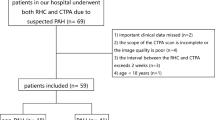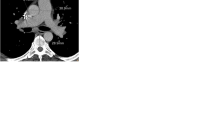Abstract
Objectives
To assess the diagnostic accuracy of automated 3D volumetry of central pulmonary arteries using computed tomography pulmonary angiography (CTPA) for suspected pulmonary hypertension alone and in combination with echocardiography.
Methods
This retrospective diagnostic accuracy study included 70 patients (mean age 66.7, 48 female) assessed for pulmonary hypertension by CTPA and transthoracic echocardiography with estimation of the pulmonary arterial systolic pressure (PASP). Gold standard right heart catheterisation with measurement of the invasive mean pulmonary arterial pressure (invasive mPAP) served as the reference. Volumes of the main, right and left pulmonary arteries (MPA, RPA and LPA) were computed using automated 3D segmentation. For comparison, axial dimensions were manually measured. A linear regression model was established for prediction of mPAP (predicted mPAP).
Results
MPA, RPA and LPA volumes were significantly increased in patients with vs. without pulmonary hypertension (all p < 0.001). Of all measures, MPA volume demonstrated the strongest correlation with invasive mPAP (r = 0.76, p < 0.001). Predicted mPAP using MPA volume and echocardiographic PASP as covariates showed excellent correlation with invasive mPAP (r = 0.89, p < 0.001). Area under the curves for predicting pulmonary hypertension were 0.94 for predicted mPAP, compared to 0.90 for MPA volume and 0.92 for echocardiographic PASP alone. A predicted mPAP > 25.8 mmHg identified pulmonary hypertension with sensitivity, specificity, positive and negative predictive values of 86%, 93%, 95% and 81%, respectively.
Conclusions
Automated 3D volumetry of central pulmonary arteries based on CTPA may be used in conjunction with echocardiographic pressure estimates to noninvasively predict mPAP and pulmonary hypertension as confirmed by gold standard right heart catheterisation with higher diagnostic accuracy than either test alone.
Key Points
• This diagnostic accuracy study derived a regression model for noninvasive prediction of invasively measured mean pulmonary arterial pressure as assessed by gold standard right heart catheterisation.
• This regression model using automated 3D volumetry of the central pulmonary arteries based on CT pulmonary angiography in conjunction with the echocardiographic pressure estimate predicted pulmonary arterial pressure and the presence of pulmonary hypertension with good diagnostic accuracy.
• The combination of automated 3D volumetry and echocardiographic pressure estimate in the regression model provided superior diagnostic accuracy compared to each parameter alone.






Similar content being viewed by others
Abbreviations
- CT:
-
Computed tomography
- CTPA:
-
Computed tomography pulmonary angiography
- LPA:
-
Left pulmonary artery
- MPA:
-
Main pulmonary artery
- mPAP:
-
Mean pulmonary arterial pressure
- mPAPpredicted :
-
mPAP predicted by linear regression
- mPAPRHC :
-
mPAP measured by right heart catheterisation
- MRI:
-
Magnetic resonance imaging
- PASP:
-
Transthoracic echocardiographic pulmonary arterial systolic pressure estimate
- PH:
-
Pulmonary hypertension
- RHC:
-
Right heart catheterisation
- RPA:
-
Right pulmonary artery
References
Galiè N, Humbert M, Vachiery J-L et al (2015) 2015 ESC/ERS guidelines for the diagnosis and treatment of pulmonary hypertension. Eur Heart J 37:67–119
Simonneau G, Gatzoulis MA, Adatia I et al (2013) Updated clinical classification of pulmonary hypertension. J Am Coll Cardiol 62:D34–D41
Tuder RM, Archer SL, Dorfmüller P et al (2013) Relevant issues in the pathology and pathobiology of pulmonary hypertension. J Am Coll Cardiol 62:D4–D12
D'Alonzo GE, Barst RJ, Ayres SM et al (1991) Survival in patients with primary pulmonary hypertension. Results from a national prospective registry. Ann Intern Med 115:343–349
Hoeper MM, Lee SH, Voswinckel R et al (2006) Complications of right heart catheterization procedures in patients with pulmonary hypertension in experienced centers. J Am Coll Cardiol 48:2546–2552
Swift AJ, Rajaram S, Hurdman J et al (2013) Noninvasive estimation of PA pressure, flow, and resistance with CMR imaging: derivation and prospective validation study from the ASPIRE registry. JACC Cardiovasc Imaging 6:1036–1047
Hammerstingl C, Schueler R, Bors L et al (2012) Diagnostic value of echocardiography in the diagnosis of pulmonary hypertension. PLoS One 7:e38519
Nowak J, Hudzik B, Jastrzebski D et al (2018) Pulmonary hypertension in advanced lung diseases: echocardiography as an important part of patient evaluation for lung transplantation. Clin Respir J 12:930–938
Johns CS, Rajaram S, Capener DA et al (2018) Non-invasive methods for estimating mPAP in COPD using cardiovascular magnetic resonance imaging. Eur Radiol 28:1438–1448
Fisher MR, Forfia PR, Chamera E et al (2009) Accuracy of Doppler echocardiography in the hemodynamic assessment of pulmonary hypertension. Am J Respir Crit Care Med 179:615–621
Kuriyama K, Gamsu G, Stern RG, Cann CE, Herfkens RJ, Brundage BH (1984) CT-determined pulmonary artery diameters in predicting pulmonary hypertension. Invest Radiol 19:16–22
Corson N, Armato SG, Labby ZE, Straus C, Starkey A, Gomberg-Maitland M (2014) CT-based pulmonary artery measurements for the assessment of pulmonary hypertension. Acad Radiol 21:523–530
Ley S, Kreitner K-F, Fink C, Heussel CP, Borst MM, Kauczor H-U (2004) Assessment of pulmonary hypertension by CT and MR imaging. Eur Radiol 14:359–368
Gerges M, Gerges C, Lang IM (2015) Advanced imaging tools rather than hemodynamics should be the primary approach for diagnosing, following, and managing pulmonary arterial hypertension. Can J Cardiol 31:521–528
Pérez-Enguix D, Morales P, Tomás JM, Vera F, Lloret RM (2007) Computed tomographic screening of pulmonary arterial hypertension in candidates for lung transplantation. Transplant Proc 39:2405–2408
Shen Y, Wan C, Tian P et al (2014) CT-base pulmonary artery measurement in the detection of pulmonary hypertension: a meta-analysis and systematic review. Medicine (Baltimore) 93:e256
Rengier F, Wörz S, Melzig C et al (2016) Automated 3D volumetry of the pulmonary arteries based on magnetic resonance angiography has potential for predicting pulmonary hypertension. PLoS One 11:e0162516
Froelich JJ, Koenig H, Knaak L, Krass S, Klose KJ (2008) Relationship between pulmonary artery volumes at computed tomography and pulmonary artery pressures in patients with- and without pulmonary hypertension. Eur J Radiol 67:466–471
Linguraru MG, Pura JA, Gladwin MT et al (2014) Computed tomography correlates with cardiopulmonary hemodynamics in pulmonary hypertension in adults with sickle cell disease. Pulm Circ 4:319–329
Linguraru MG, Pura JA, Van Uitert RL et al (2010) Segmentation and quantification of pulmonary artery for noninvasive CT assessment of sickle cell secondary pulmonary hypertension. Med Phys 37:1522
Colin GC, Gerber BL, de Meester de Ravenstein C et al (2018) Pulmonary hypertension due to left heart disease: diagnostic and prognostic value of CT in chronic systolic heart failure. Eur Radiol 62:D34–D11
Du Bois D, Du Bois EF (1916) A formula to estimate the approximate surface area if height and weight be known. Arch Intern Med 17:863–871
Sciomer S, Magrì D, Badagliacca R (2007) Non-invasive assessment of pulmonary hypertension: Doppler-echocardiography. Pulm Pharmacol Ther 20:135–140
Pepi M, Tamborini G, Galli C et al (1994) A new formula for echo-Doppler estimation of right ventricular systolic pressure. J Am Soc Echocardiogr 7:20–26
Biesdorf A, Rohr K, Feng D et al (2012) Segmentation and quantification of the aortic arch using joint 3D model-based segmentation and elastic image registration. Med Image Anal 16:1187–1201
Wörz S, Rohr K (2007) Segmentation and quantification of human vessels using a 3-D cylindrical intensity model. IEEE Trans Image Process 16:1994–2004
Wörz S, von Tengg-Kobligk H, Henninger V et al (2010) 3-D quantification of the aortic arch morphology in 3-D CTA data for endovascular aortic repair. IEEE Trans Biomed Eng 57:2359–2368
Truong QA, Massaro JM, Rogers IS et al (2012) Reference values for normal pulmonary artery dimensions by noncontrast cardiac computed tomography: the Framingham heart study. Circ Cardiovasc Imaging 5:147–154
Bujang MA, Adnan TH (2016) Requirements for minimum sample size for sensitivity and specificity analysis. J Clin Diagn Res 10:YE01–YE06
Li J, Fine J (2004) On sample size for sensitivity and specificity in prospective diagnostic accuracy studies. Stat Med 23:2537–2550
Tan RT, Kuzo R, Goodman LR, Siegel R, Haasler GR (1998) Utility of CT scan evaluation for predicting pulmonary hypertension in patients with parenchymal lung disease. Chest 113:1250–1256
Ng CS, Wells AU, Padley SPG (1999) A CT sign of chronic pulmonary arterial hypertension: the ratio of main pulmonary artery to aortic diameter. J Thorac Imaging 14:270–278
Kauffmann C, Tang A, Therasse É et al (2012) Measurements and detection of abdominal aortic aneurysm growth: accuracy and reproducibility of a segmentation software. Eur J Radiol 81:1688–1694
Kontopodis N, Metaxa E, Papaharilaou Y, Georgakarakos E, Tsetis D, Ioannou CV (2014) Value of volume measurements in evaluating abdominal aortic aneurysms growth rate and need for surgical treatment. Eur J Radiol 83:1051–1056
Devaraj A, Wells AU, Meister MG, Corte TJ, Wort SJ, Hansell DM (2010) Detection of pulmonary hypertension with multidetector CT and echocardiography alone and in combination. Radiology 254:609–616
Devaraj A, Loveridge R, Bosanac D et al (2014) Portopulmonary hypertension: improved detection using CT and echocardiography in combination. Eur Radiol 24:2385–2393
Rajani RR, Johnson LS, Brewer BL et al (2014) Anatomic characteristics of aortic transection: centerline analysis to facilitate graft selection. Ann Vasc Surg 28:433–436
Rengier F, Weber TF, Giesel FL, Böckler D, Kauczor H-U, von Tengg-Kobligk H (2009) Centerline analysis of aortic CT angiographic examinations: benefits and limitations. AJR Am J Roentgenol 192:W255–W263
Funding
This study was supported by the German Center for Lung Research (DZL) through grants from the German Ministry for Education and Science (BMBF; 82DZL00401, 82DZL00402, 82DZL00404).
Author information
Authors and Affiliations
Corresponding author
Ethics declarations
Guarantor
The scientific guarantor of this publication is Fabian Rengier.
Conflict of interest
The authors of this manuscript declare no relationships with any companies whose products or services may be related to the subject matter of the article.
Statistics and biometry
One of the authors has significant statistical expertise.
Informed consent
Written informed consent was waived by the Institutional Review Board.
Ethical approval
Institutional Review Board approval was obtained.
Methodology
• retrospective
• diagnostic or prognostic study
• performed at one institution
Additional information
Publisher’s note
Springer Nature remains neutral with regard to jurisdictional claims in published maps and institutional affiliations.
Rights and permissions
About this article
Cite this article
Melzig, C., Wörz, S., Egenlauf, B. et al. Combined automated 3D volumetry by pulmonary CT angiography and echocardiography for detection of pulmonary hypertension. Eur Radiol 29, 6059–6068 (2019). https://doi.org/10.1007/s00330-019-06188-7
Received:
Revised:
Accepted:
Published:
Issue Date:
DOI: https://doi.org/10.1007/s00330-019-06188-7




